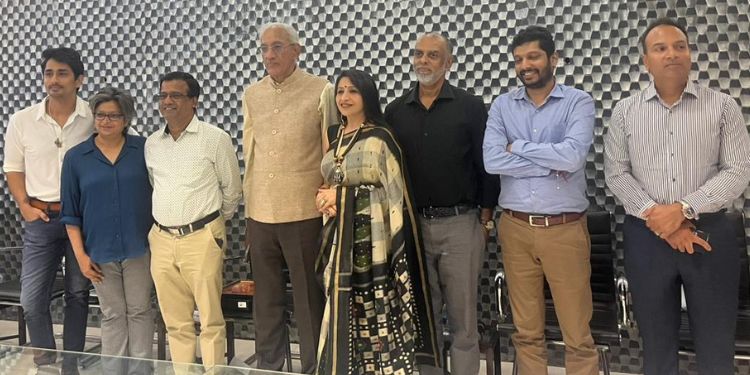The IAA Voice of Change initiative saw two panel discussions in Chennai on August 31, 2023 on “Gender Portrayal from 30 Seconds to 3 Hours”.
A session at RK Swamy Limited’s Chennai office hosted by the agency was moderated by Megha Tata, CEO, Cosmos Maya and Co-chairperson, Women Empowerment Committee, India Chapter of IAA.
It featured S Sambhu Prasad, Chairman & Managing Director, Amrutanjan Health Care; S Suresh, Managing Director, EID Parry India; actor-producer Siddharth; Atul Pujar, Head of Marketing and Product Development (Matches and Agarbati), ITC; and Bala Manian, Co-Founder and Director, OPN Advertising.
Referring to an IAA study on gender portrayals in advertising, Manian said, “There were a lot of insights from that study. I think where we need to start is, firstly, it’s no longer 30 seconds, we all have gone down to 15 seconds. And when you only have 15 seconds and 3 seconds is going to go in the brand logo and animation in the end, you have 12 seconds in which you have to establish the story. So you take every shortcut that is available, which I think is part of the reason we are where we are today. But I think the positive that we need to take out of this is also that with more digital content coming out these days people are okay with looking at things that are not particularly mainstream.”
She added, “A housewife doesn’t need to be dressed in a saree for you to establish that she is a housewife. A few years back, if there was a kind of a slightly edgier expression of a woman, I would say Fastrack. But today you have Vivel and Hamam who are okay to push the boundaries representing women. When more mainstream brands start adopting larger issues rather than just sell the soap, when you see the soap as a part of the larger narrative, then you are going to see the real change.”
Pujar noted that movies play a major role being a form of mass content. He referred to the Bechdel test in cultural representation which has three criteria: first is that there have to be two women in a scene. Second they should be talking to each other and third that the conversation should not be about a man. He explained that very few Bollywood movies pass that test.
“In Tamil cinema, the good thing was probably 20 to 25 movies passed that test. It’s clearly evident that the South is much better than the rest of the country. So, it has to start from movies, music and obviously ads have a big role to play. I think the challenge that ads face is, yes, there is stereotypical behavior that we have also done in the past like Bala mentioned. Salwar Kameez hona chahiye ya saree?” he added.
Suresh commended the IAA for its study on gender portrayals in ads in association with UNICEF and the Geena Davis Institute.
He said, “What cannot be monitored, cannot be controlled and we cannot control, cannot improve. I think that’s a wonderful first step taken. Maybe we are thinking that we are trying to do better, but there is still a lot of headroom there.”
While women are taking the lead beyond being the heads of households, there is an unwritten social order, observed Suresh.
“That is what is being demonstrated in the ads whether it is 15 seconds or 15 minutes. If you have to make a change, it is not going to be easy. But I always believe that change should have a source and the source is the marketers, the advertisers, the makers of the ads. And it is easy to control it at the source. I am of the belief that marketers are brilliant and innovative enough to even factor this new normal in,” he added.
Path to Change
Sambhu Prasad recalled ads for Amrutanjan by Shombit Sengupta’s Shining Consulting that raked up controversy.
He noted, “If you walk to our office, we have our first ad that we display from 1927 shows one lady in a very confident posture next to a bottle of Amrutanjan. Amrutanjan worked on these kinds of philosophies way before it was cool to do it.”
“In 2009, we hired Shombit Sengupta to make a new communication for brand Amrutanjan. Sengupta made some very risque ads. We got complaints from our consumers who are housewives. But, in the end, a lot of people wrote in personally because it broke certain taboo and barriers. We have businesses where 100 pc of our consumers are women like sanitary napkins or even healthcare products. I think we need to really do something much more than many and reset the trend, being the pioneer. I think there’s a lot to do here. My personal fight is broadening the definition of genders,” he explained.
Actor Siddharth said, “What’s the best thing that can come out of this discussion? Maybe one spark or one idea? In the age of explosive mass media where you hope that this one idea can then go and become change, that usually doesn’t happen.”
“If we stop wanting to make a change in the highest common factors and we start trying to improve the opportunities of the least common denominator, then I think gender is an interesting topic to speak about. I have never done an item song where the woman is assumed to be a sex object for sale. It pays me money if I do that, my films will make more money but I have never done it because I am scared of my mother, she won’t let me into the house. If you are looking at the difference between men and women – Men are from Mars, Women are from Venus – it’s so 25 years ago,” observed Siddharth.
“Today, for me, any discussion on gender has to come to the least common denominator. An individual leaves home to make a living, an individual leaves home to acquire education, an individual leaves home to survive – that individual should not have to apologise or be given the short end of the stick because of what gender they are perceived to be. If we can start discussing how this change can happen, then all conversation will have consequences,” he elaborated.
“It’s very important to make change but it’s very important to make a consequential change that we can actually see and feel and make it tangible,” he surmised.
Manian noted, “One fundamental change that we can do is to move from broadcast, where I speak and you listen, to actually creating dialogues. Once we do that and we actually open it up, for content creators, consumers and audiences to actually start reacting to the message, we will hear a wider range of voices coming out. And when the wider range comes out the stereotype will come down. It’s not going to vanish.”
Feedback: [email protected]
















